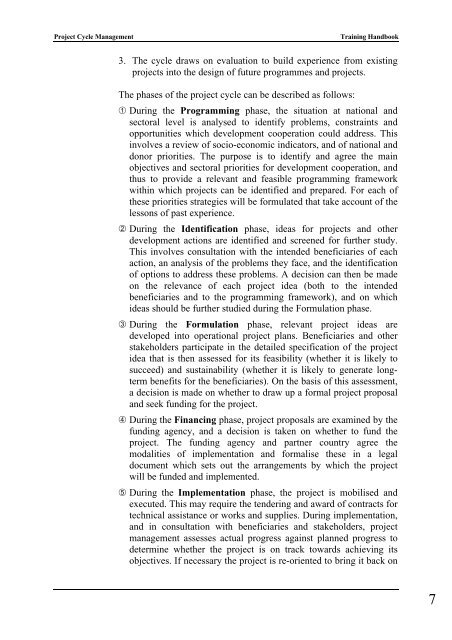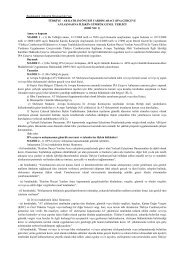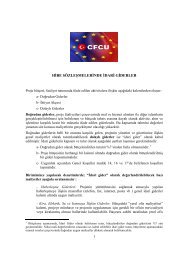Project Cycle Management Training Handbook - CFCU
Project Cycle Management Training Handbook - CFCU
Project Cycle Management Training Handbook - CFCU
You also want an ePaper? Increase the reach of your titles
YUMPU automatically turns print PDFs into web optimized ePapers that Google loves.
<strong>Project</strong> <strong>Cycle</strong> <strong>Management</strong> <strong>Training</strong> <strong>Handbook</strong><br />
3. The cycle draws on evaluation to build experience from existing<br />
projects into the design of future programmes and projects.<br />
The phases of the project cycle can be described as follows:<br />
➀ During the Programming phase, the situation at national and<br />
sectoral level is analysed to identify problems, constraints and<br />
opportunities which development cooperation could address. This<br />
involves a review of socio-economic indicators, and of national and<br />
donor priorities. The purpose is to identify and agree the main<br />
objectives and sectoral priorities for development cooperation, and<br />
thus to provide a relevant and feasible programming framework<br />
within which projects can be identified and prepared. For each of<br />
these priorities strategies will be formulated that take account of the<br />
lessons of past experience.<br />
➁ During the Identification phase, ideas for projects and other<br />
development actions are identified and screened for further study.<br />
This involves consultation with the intended beneficiaries of each<br />
action, an analysis of the problems they face, and the identification<br />
of options to address these problems. A decision can then be made<br />
on the relevance of each project idea (both to the intended<br />
beneficiaries and to the programming framework), and on which<br />
ideas should be further studied during the Formulation phase.<br />
➂ During the Formulation phase, relevant project ideas are<br />
developed into operational project plans. Beneficiaries and other<br />
stakeholders participate in the detailed specification of the project<br />
idea that is then assessed for its feasibility (whether it is likely to<br />
succeed) and sustainability (whether it is likely to generate longterm<br />
benefits for the beneficiaries). On the basis of this assessment,<br />
a decision is made on whether to draw up a formal project proposal<br />
and seek funding for the project.<br />
➃ During the Financing phase, project proposals are examined by the<br />
funding agency, and a decision is taken on whether to fund the<br />
project. The funding agency and partner country agree the<br />
modalities of implementation and formalise these in a legal<br />
document which sets out the arrangements by which the project<br />
will be funded and implemented.<br />
➄ During the Implementation phase, the project is mobilised and<br />
executed. This may require the tendering and award of contracts for<br />
technical assistance or works and supplies. During implementation,<br />
and in consultation with beneficiaries and stakeholders, project<br />
management assesses actual progress against planned progress to<br />
determine whether the project is on track towards achieving its<br />
objectives. If necessary the project is re-oriented to bring it back on<br />
7





